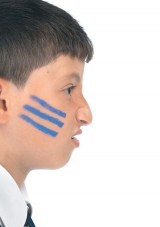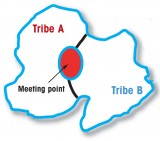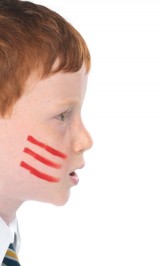Promote your class’s understanding of cultural diversity with this KS2 project from Will Ord...
‘TRIBES’ is a flexible, 10 lesson project which allows KS2 pupils to explore the concepts of culture, community and relationship within a Citizenship Education (and optionally PSHE/RE) context. Through it pupils can:
• develop their community cohesion skills
• advance their thinking and communication skills
• explore their imaginations and creativity in group contexts
• enquire into a range of key citizenship concepts
• understand the concept of a ‘culture’ more deeply
• consider consequences; what should happen when two different cultures meet?
Teachers can steer the content of TRIBES! to suit a particular topic; for example, any RE topic such as the nature of God, or beliefs, or rites of passage may be explored alongside citizenship concepts of tolerance, politics, conflict resolution, or moral reasoning. The project is essentially a structure that allows pupils to study specific ideas and simultaneously appreciate them within the much broader context of communal and multicultural life. It’s also a lot of fun and very popular with pupils!
 The class considers what communities across the globe have in common; what are the key aspects of a ‘culture’? A list is drawn up on the board and might include laws, a political structure / leader, diversity, beliefs, ceremonies, traditions, particular clothing styles, food types, symbols, rites of passage and so on. You might get them to think about what English people and Chinese people have in common to generate ideas, “They both have their own types of food”, for example.
The class considers what communities across the globe have in common; what are the key aspects of a ‘culture’? A list is drawn up on the board and might include laws, a political structure / leader, diversity, beliefs, ceremonies, traditions, particular clothing styles, food types, symbols, rites of passage and so on. You might get them to think about what English people and Chinese people have in common to generate ideas, “They both have their own types of food”, for example.
Common features of different cultures
| Laws | Food | A leader |
| Symbols | Beliefs | Ceremonies |
| Special days | Families | Schools |
| Special buildings | Hospitals | Entertainments |
Groups of four then start to create an imaginative tribe with these key aspects of a culture. What is the tribe called? Does it have symbol? What are its five most important laws? Does it worship anything? What’s its most important ceremony? Do its people get married? You might give the children a list of questions like this to prompt their thinking.
It may be worth pausing to see if pupils can connect areas of cultural life. For example, is there a connection between ceremonies and beliefs, or symbols and traditions, or rites of passage and laws? This helps pupils to appreciate the dynamic nature of a culture.
The class can explore these cultural aspects by discussing examples from real life (from history or the present day) and inventing their own equivalent expressed on a large piece of sugar paper. Imagination is particularly encouraged at this stage to engage the creativity of the pupils and involve their interests. Each tribe could be situated anywhere, in any time and have a non-human form, though a population spread of adults, children and babies is recommended to accentuate the different needs within a tribe. So, for example:
The Bee People are human-sized bees who live in hive structures made of steel and glass. They regard themselves as one big family, all loyal to the Queen Mother. They have laws to ensure each worker is treated fairly, but particularly strict ones about preserving the flowers around their hive. Flower vandals are encased in clear wax as a warning to others. Special ceremonies exist to celebrate honey making, bee births, and becoming an adult.
They believe in a supernatural force called the Hum; it’s never seen but can be felt when large gatherings of the Bee People chant together. The Bees rely on honey to survive and will die without sunshine, flowers and water. They are strictly vegetarian.
Often pupils involve their hobbies and interests in creating their cultural tribe and really go to town in making models of their villages, scrolls of their laws and even clothing.
 Once the tribe has been created, pupils are then told of an environmental catastrophe that forces two tribes to move to a single island. How will the two tribes get on? Each group shares its tribe information or ‘cultural identity’ in a tribal meeting and the children record their observations about each other. Are they compatible? What might they disagree about? Are their laws similar? How are they going to share the geography of the island together? The skills of empathy, participation, communication, negotiation and conflict resolution are developed here.
Once the tribe has been created, pupils are then told of an environmental catastrophe that forces two tribes to move to a single island. How will the two tribes get on? Each group shares its tribe information or ‘cultural identity’ in a tribal meeting and the children record their observations about each other. Are they compatible? What might they disagree about? Are their laws similar? How are they going to share the geography of the island together? The skills of empathy, participation, communication, negotiation and conflict resolution are developed here.
Pupils can then record their relationship with the other tribe in the form of a map. The map depicts the island and will show how integrated or separated the two tribes decide to become. Maybe they find that they are very incompatible, so have to divide the island with a ‘Berlin Wall’. Perhaps they need areas to be separated, but also want areas to mingle in? Would they allow marriage between the tribes? What if one tribe loves eating meat and the other is vegetarian? They might produce a ‘blended version’ of their two tribal symbols, or take minutes of their meetings. These can be very lively lessons, and often reflect the different outcomes of real cultures encountering each other; there are alliances, arguments, frustrations and triumphs!
 Pupils reflect on how different tribes have got on with each other and then consider real life examples where two cultures have met with different outcomes. Examples such as the Berlin Wall, Northern Ireland or the Middle East might be investigated, as well as national and local examples. Pupils then draw up, from their own experiences of the project, a list of ‘advice and guidelines’ for situations in which people of different cultures meet each other. What should happen if two different tribal laws contradict each other (vegetarian versus carnivore, for example)? How should different religious beliefs be reconciled, if indeed they can be? What if one tribe does not respect the traditions of the other? Should there be new laws for everybody? Ideas of tolerance, respect, freedom, rights and responsibilities can be easily discussed within a creative context here.
Pupils reflect on how different tribes have got on with each other and then consider real life examples where two cultures have met with different outcomes. Examples such as the Berlin Wall, Northern Ireland or the Middle East might be investigated, as well as national and local examples. Pupils then draw up, from their own experiences of the project, a list of ‘advice and guidelines’ for situations in which people of different cultures meet each other. What should happen if two different tribal laws contradict each other (vegetarian versus carnivore, for example)? How should different religious beliefs be reconciled, if indeed they can be? What if one tribe does not respect the traditions of the other? Should there be new laws for everybody? Ideas of tolerance, respect, freedom, rights and responsibilities can be easily discussed within a creative context here.
The tribes (on sugar paper), the island maps and the guidelines could be celebrated in a wall display for pupils to appreciate the various outcomes of tribal meetings. Alternatively, tribal groups could present the results of their tribal meetings to the rest of the class. Some teachers have used camcorders to help children record their collaboration and reflect on it to assess their learning.
Any RE topic such as the nature of God, or beliefs, or rites of passage may be explored alongside citizenship concepts of tolerance, politics, conflict resolution, or moral reasoning
Tailor the project to meet the needs and interests of your class…
This scheme of work is a very rough outline. Teachers who have used it usually find that the project takes on a life of its own and that an innovative and organic approach to the process is highly recommended. However, it’s important to keep your main objectives clear. For example, they might be:
• Collaborative, creative, critical and caring thinking (Process objectives)
• Community Cohesion, citizenship / cultural issues, diversity and tolerance (Content objectives)
• The inventive directions that these skills and concepts can be explored in can be infinitely variable.
Discover more on philosophy, citizenship education and RE at http://www.thinkingeducation.co.uk
Make World Book Day Extra Special This Year
Ace-English
5 Ways To Celebrate World Book Day
Ace-Classroom-Support
KS2 Lesson plan: China and Buddism
Ace-English
How Financial Education Helps Children
Ace-Classroom-Support
